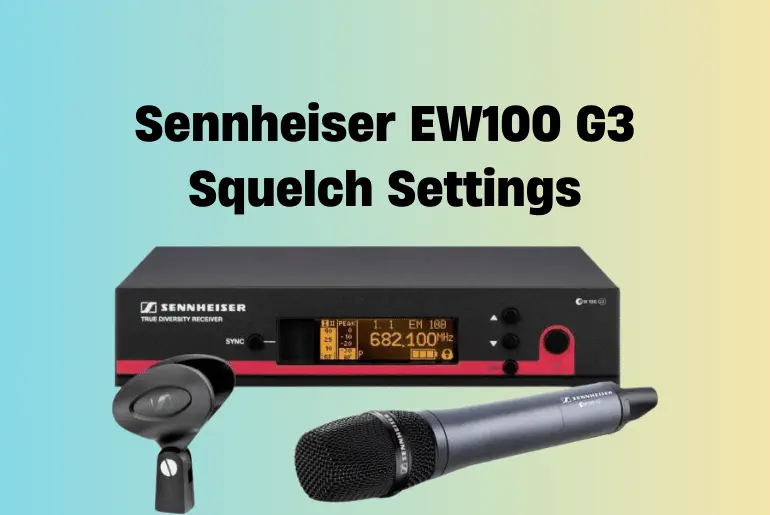In the world of professional audio equipment, few names resonate as powerfully as Sennheiser. Renowned for producing high-quality sound solutions, their EW100 G3 series is no exception. One key feature that sets this series apart from its counterparts is its squelch settings.
However, the optimal use of this feature requires a deep understanding and fine-tuning to meet the unique needs of every audio setup. In this post, we will explore the intricacies of the Sennheiser EW100 G3 squelch settings and provide you with a step-by-step approach to fine-tune your system to achieve unparalleled audio clarity.
Post Contents
Sennheiser EW100 G3 Squelch Settings
The squelch function in radio transmission, including wireless microphone systems like the Sennheiser EW100 G3, is essential for ensuring clear audio. It works by muting the audio output in the absence of a strong enough desired signal. This prevents the system from outputting random noise or interference when the desired signal is too weak or absent.
Here’s an overview of the Sennheiser EW100 G3 squelch settings:
1. Low Squelch Setting
This is ideal for environments with minimal interference. It allows for the receiver to pick up weaker signals from the transmitter, which can be especially useful if the transmitter and receiver are farther apart. However, this setting might let through unwanted noise in areas with potential interference.
2. Medium Squelch Setting
This setting provides a balance, cutting off weak signals that might carry interference while still being sensitive enough to pick up the desired transmitter signal in most environments.
3. High Squelch Setting
This setting will only allow the strongest signals to come through, which can be beneficial in areas with a lot of RF interference. However, if the transmitter and receiver are at a greater distance, this setting might mute the desired signal if it becomes too weak.
How Do You Adjust the Squelch on Sennheiser EW100 G3
- Turn on the receiver and transmitter.
- On the receiver, navigate using the arrow buttons to the “Squelch” setting in the menu.
- Once you’ve accessed the squelch settings, you can adjust the level using the +/- buttons. You’ll typically have options like ‘Low’, ‘Mid’, and ‘High’, or it might be represented in decibels (dB).
- After adjusting, make sure to test the system in its intended environment to ensure clear audio transmission without dropouts.
Key Features of Sennheiser EW100 G3
The Sennheiser EW100 G3 series is a popular range of wireless microphone systems known for its reliability and versatility in various applications, from live performances to broadcasting. While the specifics might vary based on the particular model or setup, some key features of the EW100 G3 series include:
- UHF Transmission: The EW100 G3 operates within the UHF (Ultra High Frequency) range, providing reliable transmission over longer distances and with fewer interference issues.
- Enhanced Frequency Bank System: With up to 12 compatible frequencies, the system can handle multiple devices operating simultaneously without interference.
- Auto Frequency Scan: This feature allows for easy searching of available frequencies to find the best transmission channel, which is especially useful in congested RF environments.
- Pilot Tone Squelch: The receiver is equipped with a pilot tone squelch circuit to eliminate RF interference when the transmitter is turned off.
- Illuminated Graphic Display: The system’s user-friendly design includes an illuminated graphic display on both the transmitter and receiver, ensuring easy readability under various lighting conditions.
- HDX Compander: Ensures crystal clear sound quality by reducing background noise and enhancing the clarity of the audio signal.
- Auto-Lock Function: Prevents accidental changes to settings, ensuring that they remain intact once your desired configurations are set.
- Rugged Metal Housing: Both the transmitter and receiver come in robust metal housing, making them durable for heavy-duty usage.
- Infrared Sync: This facilitates the quick syncing of transmitter and receiver settings, ensuring that the two units can communicate effectively without manual tuning.
Conclusion
When effectively harnessed, Squelch settings can be a game-changer for audio professionals using the Sennheiser EW100 G3 system. They act as a gatekeeper, ensuring that only the desired sounds are transmitted while unwanted noise is kept at bay.
While the process may seem daunting at first, with a systematic approach and understanding of the underlying principles, one can significantly enhance audio transmission quality. Remember, the aim is not just to eliminate noise but to bring forth the richness and clarity that the EW100 G3 series promises.

